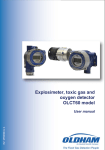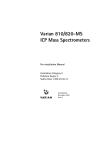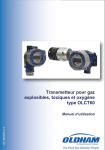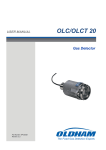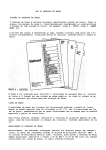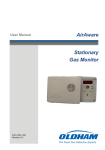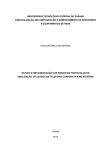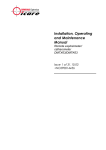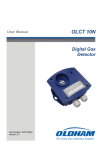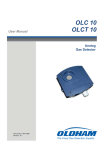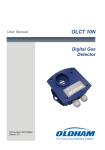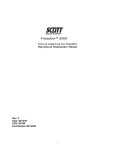Download OLDHAM OLCT 60 Manual
Transcript
User manual OLCT 60 Fixed Point Gas Monitor Part Number: NPO60GB Revision: C.3 The Fixed Gas Detection Experts Copyright 2015 by Oldham S.A.S. All rights reserved. No reproduction of all or part of this document, in any form, is permitted without the written consent of Oldham S.A.S.. All of the information that is provided in this document is accurate to the best of our knowledge. As a result of continuous research and development, the specifications of this product may be changed without prior notice. Oldham S.A.S. Rue Orfila Z.I. Est – C.S. 20417 F – 62027 ARRAS Cedex Tel: +33 (0)3 21 60 80 80 Fax: +33 (0)3 21 60 80 00 email: [email protected] web: www.oldhamgas.com 2 OLCT 60 User manual Contents Chapter 1 | Overview 7 Purpose ........................................................................................................ 7 Operating principle ....................................................................................... 8 Composition of the Detector......................................................................... 9 External view .............................................................................................. 10 Internal view ............................................................................................... 12 Labels and pictograms ............................................................................... 12 Visual indication ......................................................................................... 13 Chapter 2 | Installation 17 Regulations and conditions of use ............................................................. 17 Necessary equipment ................................................................................ 17 Location of the detector .............................................................................. 17 Detector positioning ................................................................................... 18 Electrical Specifications ............................................................................. 20 Connecting cable ....................................................................................... 20 Cable connection ....................................................................................... 21 Scope of use .............................................................................................. 25 Transfer curve ............................................................................................ 25 Chapter 3 | Commissioning and operating modes 27 Purpose of control ...................................................................................... 27 Necessary equipment ................................................................................ 27 Commissioning ........................................................................................... 28 Stabilization time ........................................................................................ 28 Display of the gas measurement................................................................ 29 Checking Zero ............................................................................................ 30 Checking gas sensitivity ............................................................................. 31 Chapter 4 | Preventive maintenance 33 Maintenance schedule ............................................................................... 33 Actions ........................................................................................................ 34 Chapter 5 | Maintenance 35 Possible errors ........................................................................................... 35 Replacing sensor block (Explo, O2, Tox, XPIR) ......................................... 36 Replacing the OLCT IR – integrated version ............................................. 37 Contents 3 Replacing the OLCT IR – remote version .................................................. 37 Initialization of the sensor block ................................................................. 38 Zeroing and sensitivity adjustment (calibration) ......................................... 40 Adjusting the optical zero (Ir-0) .................................................................. 45 Applicable coefficients for explosive gas calibration .................................. 47 Checking the line current ........................................................................... 50 Chapter 6 | Accessories 51 Chapter 7 | Spare parts 53 Explosionproof sensor block ...................................................................... 53 Intrinsically safe sensors ............................................................................ 55 Chapter 8 | Declaration of EC Conformity 57 Chapter 9 | Technical Specifications 61 Dimensional characteristics ....................................................................... 61 Complete detector ...................................................................................... 63 Measuring sensors ..................................................................................... 65 Chapter 10 | Special instructions for use in explosive environments and functional safety 67 General comments ..................................................................................... 67 Metrological performance for the detection of flammable gases or oxygen ........................................................................................................ 67 Threaded joints........................................................................................... 68 Functional Safety ....................................................................................... 68 Reliability data ............................................................................................ 68 Chapter 11 | Fault and error codes 71 Errors (E xx) ............................................................................................... 71 Faults (dEF xx) ........................................................................................... 71 4 OLCT 60 User manual Thank you for choosing this OLDHAM instrument. All of the necessary actions have been taken to ensure your complete satisfaction with this equipment. It is important that you read this entire manual carefully and thoroughly. Limitation of Liability OLDHAM shall not be held responsible for any damage to the equipment or for any physical injury or death resulting in whole or in part from the inappropriate use or installation of the equipment, non-compliance with any and all instructions, warnings, standards and/or regulations in force. No business, person or legal entity may assume responsibility on behalf of OLDHAM, even though they may be involved in the sale of OLDHAM products. OLDHAM shall not be responsible for any direct or indirect damage, or any direct or indirect consequence, resulting from the sale and use of any of its products UNLESS SUCH PRODUCTS HAVE BEEN SELECTED BY OLDHAM ACCORDING TO THE APPLICATION. Ownership clauses The drawings, specifications, and information herein contain confidential information that is the property of OLDHAM. This information shall not, either in whole or in part, by physical, electronic, or any other means whatsoever, be reproduced, copied, divulged, translated, or used as the basis for the manufacture or sale of OLDHAM equipment, or for any other reason without the prior written consent of OLDHAM. Limitation of Liability 5 Warnings This is not a contractual document. In the best interest of its customers and with the aim of improving performance, OLDHAM reserves the right to alter the technical features of its equipment without prior notice. READ THESE INSTRUCTIONS CAREFULLY BEFORE THE FIRST USAGE: these instructions should be read by all persons who have or will have responsibility for the use, maintenance, or repair of the instrument. This instrument shall only be deemed to be in conformance with the published performance if used, maintained, and repaired in accordance with the instructions of OLDHAM, by OLDHAM personnel, or by personnel authorized by OLDHAM. Warranty Under normal conditions of use and on return to the factory, parts and workmanship are guaranteed for 2 years, excluding consumables such as sensors, filters, etc. Disposal of the equipment European Union only. This symbol indicates that, in conformity with DEEE Directive (2002/96/EC) and according to local regulations, this product may not be discarded together with household waste. It must be disposed of in a collection area that is set aside for this purpose, for example at a site that is officially designated for the recycling of electrical and electronic equipment (EEE) or a point of exchange for authorized products in the event of the acquisition of a new product of the same type. 6 OLCT 60 User manual Chapter 1 | Overview Purpose OLCT 60 gas detectors are 4-20mA and 3-wire transmitters designed for measuring combustible and toxic gases as well as oxygen. OLCT 60 is available in two versions: Flameproof certified enclosure along with flameproof certified sensor block. This version is listed as OLCT 60d. Flameproof certified enclosure along with intrinsically safe certified sensor block. This version is available for electrochemical sensors only. This version is listed as OLCT 60id. Available versions are listed below. OLCT 60d OLCT 60id Catalytic sensor Electrochemical sensor XPIR Infrared sensor OLCT IR Infrared sensor Table 1: Comparison of OLCT 60 detectors Each version features two options: OLCT 60 version with on-board sensor. The sensor can either be flameproof or intrinsically safe certified depending on the version of the detector. OLCT 60D version with remote sensor. The sensor can either be flameproof or intrinsically safe certified depending on the version of the detector. 1 - Overview 7 Available combinations are listed below. Name Description OLCT 60 Flameproof enclosure with onboard sensor (FLP or IS*). OLCT 60D Flameproof enclosure with remote sensor 15m (FLP or IS*). OLCT 60 / OLCT IR Flameproof enclosure with onboard infrared sensor type OLCT IR. OLCT 60D / OLCT IR Flameproof enclosure with remote infrared transmitter type OLCT IR. Illustration 044 046 048 050 (*) FLP stands for flameproof, IS stands for intrinsically safe. The IS version is distinguished - among other features - by the color of its housing which is blue. FLP versions are unpainted stainless steel. Operating principle The sensor converts the target gas into current. The current value is amplified, temperature compensated, linearized, and converted to a 4-20 mA signal proportional to the gas concentration and then conveyed through a connecting cable to a centralization system (gas controller or PLC). Sensor type depends on the gas to be detected and the version of OLCT 60 as shown in Table 1: Comparison of OLCT 60 detectors on page 7. 8 OLCT 60 User manual Composition of the Detector OLCT 60 detectors contain the following parts: Id. Description 1. Label 2. Cover 3. Display board 4. Terminal board 5. On-board sensor 6. Enclosure 7. M25 cable gland (until August 2014) 8. Remote sensor 9. Cable for remote sensor 10. Adapter 11. On-board OLCT IR infrared sensor 12. Remote OLCT IR infrared transmitter 004 Figure 1: Main components of OLCT 60 detectors 1 - Overview 9 External view Overview Id. Description 1. Digital display. See Figure 3 for more details. 2. Ground terminal 3. Cover fixation screw 4. Cable gland (until August 2014) 5. On-board sensor. See 7 for more details. 6. Remote sensor. See 7 for more details. 7. On-board OLCT IR infrared sensor head. See 7 for more details. 8. Remote OLCT IR infrared transmitter. See 7 for more details. 012A OLCT 60 OLCT 60D with remote sensor block 012B OLCT 60/OLCT IR on-board OLCT 60/OLCT IR remote 012 Figure 2: OLCT 60 overview 10 OLCT 60 User manual Difference between FLP and IS sensors Although they have different ATEX marking, intrinsically safe and flameproof sensors are distinguished by the color of the sensor block as following: Flameproof sensor: unpainted stainless steel enclosure equipped with a flame arrestor, Intrinsically safe sensor: blue painted stainless steel enclosure equipped a PTFE membrane. Display and LEDs Id. Description 1. Digital display indicates: - Gas concentration and gas type alternately with gas unit. If an error occurs, the respective error code is displayed and Fault LED is lit on. Please revert to section Readings on the display, page 14. - Maintenance menus. Please revert to section Menus, page 14. 2. Magnetic switch 3. Fault LED (orange) 4. Power LED (green) 5. Magnetic switch 6. Magnetic wand 018 Figure 3: General Status Screen 1 - Overview 11 Internal view Id. Description 1. Electronic circuit board 2. Terminal block 006 Figure 4: Detector internal view (with display board removed) Labels and pictograms The detector has two identification labels, as shown below: Certification label Id. Description 1. ATEX marking 2. Type of product 3. Manufacturer's name 4. IECEx marking and ATEX certification temperature range (is not the operating temperature range) 5. Warning 6. CE and ATEX marking 12 OLCT 60 User manual 008 Figure 5: Certification label P/N label This label is located on the side of the enclosure and contains the following information: Id. Description 1. Part Number of the OLCT 60 without sensor 2. Disposal icon 3. Serial Number 010 Figure 6: Side label Visual indication At startup Display shows: Initialization screen. All LCD segments and LEDs turn on L_00 Firmware version L_02 Batch number L_04 Serial Number L_06 Gas concentration reading once initialization and stabilization are completed L_008 Figure 7: Warm-up screen 1 - Overview 13 In normal operation In normal operation, the display alternately shows the gas concentration, the type of gas and the gas unit. The OK green indicator is lit on; the FAULT indicator is turned off. Indicator Lit Off OK OLCT 60 is powered OLCT 60 is not powered FAULT Detector in fault or in maintenance mode See Fault mode screen Normal Operation L_010A L_010B Figure 8: OLCT 60 in normal operating mode Fault mode screen The display indicates DEF or the fault code (see page 71 for more warning code information). Simultaneously, the FAULT indicator lights on and the icon is displayed. L_014A L_014B Figure 9: OLCT 60 in fault mode Maintenance Menus Access 034 You can access the menus without opening the enclosure thanks to a magnet (rep. 1) that must be placed over (rep. 2). Figure 10: place the magnet over ‘VALID’ to access the menus 14 OLCT 60 User manual Gas calibration menu The menu is different depending on whether the OLCT 60 is equipped with an OLCT IR infrared sensor. Normal operating mode (page 29) (page 40) (page 37) L_022_A (page 45) L_022B Figure 11: Gas calibration menu (on the right: OLCT 60 equipped with an OLCT IR infrared sensor) CAL: zero and span calibration. See page 40. Init: sensor replacement. See page 38. Ir-0: OLCT IR zeroing. See page 45. 1 - Overview 15 16 OLCT 60 User manual Chapter 2 | Installation Please read the guidelines on the installation, use and maintenance of detectors for detection of flammable gases and oxygen (standard EN/IEC 60079-29-2) and toxic gases (standard EN 45544-4). Regulations and conditions of use The installation will be done according to current standards for installation in explosive areas especially regulations IEC/EN 60079-14 and IEC/EN 60079-17 (current editions) or according to other national standards. The equipment is authorized for use in Zones 1, 2, 21 and 22 and is certified for ambient temperatures from -20 °C to + 60 °C. Note that this is not the operating temperature which, by the way, is sensor dependent. Regarding the OLCT 60D-id version, the remote sensor can be used in zones 0, 1, 2, 20, 21 and 22. The transmitter itself is for use in zones 1, 2, 21 and 22 only. The detector must always be in contact with the ambient air. Thus: - Do not cover the sensor, - Do not paint the sensor, - Avoid dust deposits. Necessary equipment Complete detector assembly Cable Tools Fixing hardware Multimeter (intrinsically safe certified when needed) Location of the detector Depending on the density of the gas to be detected or the application, the detector shall be positioned at ground level, or on the ceiling at the same height as the airflow, or near air extraction ducts. Heavy gases may be detected at the ground level, while light gases will be found at ceiling height. Gas densities are found on page 46. 2 - Installation 17 Detector positioning All versions excluding OLCT IR The OLCT 60 will be installed with the sensor pointing downwards. For combustible gas detectors only, any tilt of more than 45° from the vertical will lead to an inaccurate measurement. Fixing the enclosure will be performed by using 2 x M6 screws and the appropriate plugs for the supporting material. A special holder is available for mounting the detector on the ceiling (see chapter Accessories). 016 Figure 12: installation of an OLCT 60 with on-board sensor 036 Figure 13: installation of an OLCT 60D with remote sensor 18 OLCT 60 User manual OLCT 60 with local or remote OLCT IR The infrared sensor shall be installed horizontally with the arrow on the splashguard pointing upwards. Fixing the detector will be performed by using 2 x M6 screws and the appropriate plugs for the supporting material. 030 Figure 14: OLCT IR detector MUST be laid horizontally, arrow pointing upwards 30m (100 ft) max. 056 Figure 15: OLCT IR detector must be laid horizontally, arrow pointing upwards 2 - Installation 19 Electrical Specifications Type of sensor Input Voltage (Vdc) Maximum current (mA) Power consumption (W) Catalytic 16 to 32 140 2.24 Infrared (XPIR) 16 to 32 120 1.92 Infrared (OLCT IR) 16 to 32 550 8.80 Electrochemical 16 to 32 80 1.28 Semiconductor 16 to 32 140 2.24 Connecting cable The detector shall be connected to the controller with a 3-wire shielded cable. Core size depends on the specific requirements of the installation, the distance and type of detector (see table below). 022 Type of detector Type of sensor Maximum length (km) depending on the core size 0..5mm² (AWG20) 0.9mm² (AWG18) 1.5mm ² (AWG15) Maximum load resistance () Explosimeter Catalytic 0.55 1.0 1.7 250 Explosimeter Infrared (XPIR) 0.65 1.2 2.0 250 Explosimeter Infrared (OLCT IR) 0.13 0.25 0.45 300 Toximeter Electrochemical 1.0 1.8 3.0 250 Oxygen detector Electrochemical 1.0 1.8 3.0 250 Freon Semiconductor 0.55 1.0 1.7 250 Table 2: Maximum distance cable (with 24 Vcc at controller terminals) The cable must be shielded to reduce the influence of electrical and radio-frequency interference. A cable such as AFNOR M 87-202-01-IT-15-EG-FA (Nexans) may be used. It shall be selected according to the type of detector and in accordance with the table shown hereinabove. Here are some more examples of suitable cables: Safe area: CNOMO FRN05 VC4V5-F ATEX zone: GEVELYON (U 1000RHC1) ATEX zone: GVCSTV RH (U 1000) ATEX zone: xx-xx-09/15- EG-SF or EG-FA or EG-PF (U 300 compatible with M87202). The maximum permissible length will depend on the cross-section of the cable conductors (see table) and on the minimum admissible supply voltage at the detector terminals. 20 OLCT 60 User manual Cable connection Turn off the line On the controller: 1. Inhibit any alarms to prevent false alarms during operation. 2. Switch off the power supply to the detector. Opening of the detector Loosen the 4mm hex screw (rep.1) locking the cover before removing the detector cover. 032 Figure 16: Locking screw of the cover Cable preparation The cable will be supplied from the controller at the measurement point. The passage, support, and protection of the cable shall be done according to best practice. Cable entry It is essential to follow the instructions given by the manufacturer of the cable gland and to connect the shielding properly. Cable-gland or adaptor shall be M25 x 1.5 and flameproof certified. 2 - Installation 21 Detector Washer Shield Seal Shielding device Non-armoured cable Cable clamp 060 Figure 17: non-armoured cable gland type Detector r Seal Seal Armoured cable Armour grounding 062 Figure 18: armoured cable gland type Cable connection (OLCT 60) Remove power before wiring the OLCT 60 to the controller. The site must be equipotential. Connect the cable to the detector first and then connect the controller. Once the wiring is completed, connect the shield of the cable to the ground terminal of the controller. + 24 Vcc 0V Signal 026 Figure 19: wiring the OLCT 60 (d or id version) 22 OLCT 60 User manual Cable connection (OLCT 60/OLCT IR remote) Remove power before wiring the OLCT 60 to the controller. The site must be equipotential. First carry out the connection between the OLCT IR (rep. A) and the detector (rep. B) as shown in Figure 20. The maximum distance is 30 meters (100 feet). The type of cable to use is 01-IQ-09-EG-FA or EG-SF or similar; see page 20. Then connect the OLCT 60 as described previously. 30m (100 ft) maximum 042 Figure 20: wiring the OLCT 60D/OLCT IR. Ensure the specificity of the numbering of the connector marked «D» compared to the connector marked «E». 2 - Installation 23 Detector grounding Connect the enclosure ground points to earth according to the regulations with a 4mm² (11 AWG) wire. The OLCT 60 features an internal ground point as well. The internal grounding shall be preferred as the primary equipment ground. 028 Figure 21: OLCT 60 grounding Closing the cover Before connecting the OLCT 60 to the controller, the cover shall be tightly closed. Firmly tighten the locking screw as well (see Figure 16, page 21). 24 OLCT 60 User manual Scope of use Gas sensors have limitations that must be observed (see Chapter 10 | Special instructions for use in explosive environments and functional safety). Presence of specific components Vapors from components containing silicone or sulfur can affect the catalytic sensors and thereby distort measurements. If sensors have been exposed to these types of compounds, a bump test shall be performed. High concentrations of organic solvents (e.g. alcohols, aromatic solvents, etc.) or exposure to quantities of gas greater than the specified range of measurement can damage the electrochemical sensors. Inspection or calibration is then recommended. In the presence of high concentrations of carbon dioxide (CO2 > 1% vol.), the oxygen-measuring electrochemical sensors can slightly overestimate the concentration of oxygen (0.1 to 0.5% volume O2 overestimate). Operation under low oxygen levels If an electrochemical sensor is used in an atmosphere comprising less than 1% oxygen for over one hour, the measurement may be an underestimate. If a catalytic sensor is used in an atmosphere comprising less than 10% oxygen, the measurement may be an underestimate. If a semiconductor detector sensor is used in an atmosphere comprising less than 18% oxygen, the measurement may be an underestimate. Transfer curve The curve shown gives the transmitter output current as a function of the gas concentration. If you connect the transmitter to a different unit than the one provided by Oldham, you should be certain that the transfer curve is fully compatible with the input characteristics of your device to ensure proper interpretation of the information provided by the transmitter. Similarly, the unit should provide sufficient voltage to compensate for any voltage drop in the cable. Output signal (mA) Default Default % of the measuring range 014 Figure 22: OLCT 60 transfer curve 2 - Installation 25 26 OLCT 60 User manual Chapter 3 | Commissioning and operating modes The tasks described in this chapter should only be performed by authorized and trained personnel as they are likely to jeopardize the reliability of detection. This chapter describes: how to check the zero how to check the sensitivity the various operating modes Purpose of control Upon delivery, each detector has been tested and calibrated. There is normally no need for a new calibration. However, for safety, it is advisable to check the zero and the sensitivity as shown below. The detector cover shall remain completely closed since the adjustments are carried out through the window. For flammable gas detector, we always recommend to calibrate the sensor with the targeted gas. When the user wishes to calibrate the detector with a different gas, refer to the table on page 46 for the use of recommended gas and corresponding coefficient. Necessary equipment Zero grade air cylinder Appropriate span gas cylinder (gas concentration should be between 30 and 70% of the measurement range) Calibration cup (see Chapter Accessories) 3 – Commissioning 27 Commissioning Prior checks Check the following points: Wiring completed Detector grounded Shielding grounded at controller side Integrity of the mechanical mounting (fixings, cable gland, and cover) ensured Powering up detector 1. Inhibit any alarms to avoid false alarms during operation 2. Apply power to the OLCT 60 Stabilization time Before initial calibration allow the detector to stabilize after applying power. Any adjustment before the time indicated will result in an incorrect measurement, which may in turn compromise the safety. The total waiting time is summarized below: Catalytic bead sensor: 2 hours Oxygen sensor: 1 hour Electrochemical sensor: 1 hour, excluding: - NO (Nitrogen Monoxide): 12 hours - HCl (Hydrogen Chloride): 24 hours - ETO (Ethylene Oxide): 36 hours Semiconductor sensor: 4 hours Infrared sensors (XPIR and OLCT IR): 2 hours 28 OLCT 60 User manual Display of the gas measurement Normal operating mode Alternately, the display shows the measured concentration and the type of gas. The OK green indicator is lit; the FAULT indicator is off. L_00 Figure 23: Normal operating mode Fault mode In fault condition, the display indicates «dEF» followed by the fault code. In the event of an internal electronic error, the display indicates «E» followed by the error code. In both cases, the FAULT indicator is lit. Proceed with the corrective action in compliance with page 35. See page 71 for more warning code information. L_00 Figure 24: Fault mode Over-Range condition (catalytic version only) For safety reasons, when measuring a concentration of a flammable gas above 100% LEL, the display indicates «SUP» and the FAULT indicator is lit. Meanwhile the analog output signal is set at 23.2 mA. To exit this mode, swipe the magnet over once you have checked the absence of any explosive atmosphere with a portable combustible gas monitor for example. L_00 Figure 25: Over-Range indication 3 – Commissioning 29 Checking Zero Proceed as follows: 024 Figure 26: Checking Zero 1. Inhibit any alarms on the controller. 2. Place the calibration cup over the sensor (Figure 26, rep. B). 3. Connect the calibration cup to the zero gas cylinder (rep. E) by using a tubing in PTFE (Pos. C). 4. Apply the gas (flow regulator set to 0.5-1.0 liter per minute (LPM) or 1.0-2.0 LPM for OLCT IR versions) (rep. D). 5. Once the measure is stabilized (approx. 2 minutes), read the value on the display (rep. A). 6. If the expected value does not comply, proceed with the calibration (paragraph Zeroing and sensitivity adjustment, on page 40). 7. Continue with Checking gas sensitivity on the next page. 30 OLCT 60 User manual Checking gas sensitivity For safety reasons, this procedure must be carried out after the control of the zero (page 29). Proceed as follows: 038 Figure 27: Checking gas sensitivity 1. Once the detector is zeroed, connect the calibration cup to the calibration gas cylinder (Pos. E) by using a tubing in PTFE (Pos. C) to prevent the adsorption of reactive gases (i.e.: HCl, SO2, Cl2, etc.) at the surface of the tube. 2. Open the valve on the gas cylinder (flow rate 0.5 to 1 LPM or 1 to 2 LPM in the case of OLCT IR versions) (rep. D). 3. Once the measurement is stabilized (approx. 2 minutes), read the value on the display (rep. A). 4. If the expected value does not comply, proceed with the calibration (paragraph Zeroing and sensitivity adjustment, on page 40). 5. Close the valve (rep. D) of the gas cylinder and remove the calibration cup (rep. B). Wait for the measurement to return to zero and reset the alarms on the controller. The control of zero and gas sensitivity is now completed. 3 – Commissioning 31 32 OLCT 60 User manual Chapter 4 | Preventive maintenance Periodic checks enable the equipment and installation to remain in conformity and ensure reliable detection. This chapter describes what preventative action should be taken and at what intervals. Inspection and maintenance are carried out in accordance with EN/IEC 60079-17 standard in force or with other national standards. Maintenance schedule Gas detectors are safety devices. OLDHAM recommends the regular testing of fixed gas detection installations. This type of test consists of injecting the calibration gas into the detector at a sufficient concentration to activate the pre-set alarms. It is to be understood that this test is in no way a replacement for a detector calibration. The frequency of gas tests depends on the industrial application where the detector is in use. Frequent inspections should be made in the months following the commissioning of the installation, and should then become more widely spaced provided that no significant deviation is observed. If a detector should fail to react in contact with the gas, calibration is essential. The frequency of calibrations shall be appropriate according to the results of the tests (humidity, temperature, dust, etc.); however, it must not exceed one year. The general manager should put safety procedures in place on-site. OLDHAM cannot be held responsible for their enforcement. When used in a SIL 1 system, according to European standard EN 50402, Requirements relating to the safety operation of fixed gas detection systems, the maintenance interval for combustible gas detectors shall not exceed 6 months. For SIL 2 systems, the maintenance interval shall not exceed 3 months. 4 – Preventive maintenance 33 Actions OLCT 60 Periodic maintenance comprises the following actions: Removal of dust from the sensor and its optional protective cover with a dry cloth only. No water or solvents should be used. Severely dusty sensors should be replaced immediately. For use in dusty explosive atmospheres, the user should undertake full and regular cleaning to avoid the build-up of dust. The maximum permissible thickness of a dust layer must be less than 5 mm. Replacement of screws: if any screws on the flameproof part need to be replaced, screws of equal quality or better than A4.70 should be used. Zero inspection with zero grade air; see page 29. In case of variance, comply with the actions described in this paragraph. Gas sensitivity check; see page 30. In case of variance, comply with the actions described in this paragraph. OLCT 60/ OLCT IR Refer to the specific OLCT IR manual. 34 OLCT 60 User manual Chapter 5 | Maintenance Maintenance primarily comprises changing any sensors that no longer meet their initial metrological characteristics. Since they are liable to affect detection reliability, the tasks described in this chapter are reserved for authorized trained personnel only. Inspection and maintenance shall be carried out in accordance with EN/IEC 60079-17 standards in force or with other national standards. Possible errors The table below summarizes the various possible detector errors. Observed default Possible cause Action current output is at 0 mA Connector cable Power supply Check cable Check voltage at detector terminal Electronic card Change board Sensor Line resistance too high Power supply Change sensor Check cable Check voltage at detector terminal 36 Improper calibration gas Check the content of the calibration gas - Zero setting not possible Sensor Electronic card Change sensor Change board 36 Sensitivity adjustment not possible Sensor Electronic card Change sensor Change board 36 «SUP» display Over-Range condition Valid with the magnet 29 Check the span 42 0 mA < current output < 1mA (page ) 50 - 5 - Maintenance - 35 Replacing sensor block (Explo, O2, Tox, XPIR) This paragraph is not applied to OLCT IR. Refer to the two paragraphs Replacing the OLCT IR on the next page. The sensor block or detection module encloses the sensitive element and the corresponding electronics. A sensor block can only be associated with a defined detector; so an oxygen detection module will not be installed in the place of a LEL detection module. Frequency of replacement The sensor block needs to be replaced every time when zeroing, performing gas calibration or preventive maintenance are no longer possible. Exchanging of the sensor Step 36 Action 1. Prepare the following elements: New sensor block 4 mm Allen wrench Calibration set (gas cylinder, calibration cup, etc.). 2. Inhibit the alarms on the controller. 3. Turn the OLCT 60 off. 4. Loosen the locking screw in the sensor head and rotate the sensor head 30 degrees counterclockwise. 5. Unplug the connector and remove the defective sensor head. 6. Replace the worn out detector head with an identical new one. 7. Reassemble in reverse order and tighten the locking screw. 8. Power the OLCT 60. 9. Install the OLCT 60 as explained in detail in the Initialization of the sensor block paragraph on page 37. OLCT 60 User manual Replacing the OLCT IR – integrated version Contact the manufacturer or distributor. Replacing the OLCT IR – remote version Exchanging the detector Step Action 1. Prepare the following elements: New OLCT IR detector 4 mm Allen wrench Calibration set (gas cylinder, calibration cup, etc.). 2. Inhibit the alarms on the controller. 3. Turn the OLCT 60 off. 4. Open the defective OLCT IR and disconnect it. 5. Dismount the defective OLCT IR and put the new one in. 6. Carry out the connections. Refer to the Connection of the cable (OLCT 60/OLCT IR remote version) paragraph on page 22. 7. Reassemble in reverse. 8. Power the OLCT 60. 9. Install the OLCT 60 as explained in detail in the Initialization of the sensor block paragraph on page 37. 5 - Maintenance 37 Initialization of the sensor block Selection of the initializing menu (Init) Step Action 1a. After the startup phase, the screen will show the gas measurement (it may be wrong at this point). Place the magnet over for 3 seconds. Illustration 1b. Until the L_020A icon is displayed... _L020B ...present the magnet 3 consecutive times on the in the 3 seconds. L_020B 1c. The calibration menu (CAL) is displayed. 1d. Place the magnet over 1e. The initialization menu (Init) is displayed. L_020c . L_Init Initialization of the sensor block This procedure resets the electrical parameters of the sensor. Step Action Illustration 2a. The Init screen is displayed, place the magnet over . L_020B 2b. The display indicates «CnF» (Confirmation). 2c. Place the magnet over L_044 38 OLCT 60 User manual . 2d. The display indicates «nOn» (No). 2e. Place the magnet over No to Yes. 2f. Place the magnet over to validate the choice. The procedure is then ended and the detector automatically resets. 2g. Wait 4 seconds during the display of the startup page. 2h. The version number of the software is displayed. 2i. The manufacturing date code is displayed. 2j. The serial number is displayed. 2k. Countdown starts before return in normal mode. 2l. When the countdown is ended, the display shows the gas measurement. The OLCT 60 is in normal mode. 2m. Subsequently check the gas operation as explained on pages 29 and 30. L_048 to change L_046 L_00 L_02 L_04 L_06 L_059 L_020A 5 - Maintenance 39 Zeroing and sensitivity adjustment (calibration) This paragraph will be followed to the extent that the zero control (page 29) and/or the sensitivity (page 30) show a variance from the expected values. For safety reasons, it is important to proceed with the full calibration (zero and span settings). In the event of a voluntary or an automatic abandon of the procedure, the previous values will be maintained. OLCT 60 leaves the maintenance mode and returns to normal operation after 10 minutes of inactivity on the or . The detector cover shall remain completely closed since the adjustments are carried out through the window. For flammable gas detector, we always recommend to calibrate the sensor with the targeted gas. When the user wishes to calibrate the detector with a different gas, refer to the table on page 46 for the use of recommended gas and corresponding coefficient. FOR OLCT IR infrared versions It is imperative to zero the optics before proceeding as indicated in the Optical zeroing on page 45 Passage in calibration mode Step Action Illustration 1a. Place the magnet over seconds. 1b. Until the for 3 L_020A icon is displayed... _L020B ...present the magnet 3 consecutive times on the in the 3 seconds. L_020B 1c. The calibration menu (CAL) is displayed. L_020c 40 OLCT 60 User manual Zeroing Step 2a. Action Illustration The calibration menu (CAL) is displayed. L_020C Position the magnet over . 2b. The display now shows “-0-” indicating the beginning of the zero-setting phase. 2c. Position the magnet over 2d. The display indicates the current value. 2e. Place the calibration cup and inject zero grade air at 0.5 to 1 LPM (1 to 2 LPM for OLCT IR versions). Wait approximately 2 minutes for the stabilization of the measure. L_024 . L_026 The zero of a CO2 sensor block must be tested with a zero grade air cylinder or with nitrogen. Never consider ambient air as a zero value. 2f. The display eventually indicates a value that is different than zero. Place the magnet over to confirm the zero adjustment. 2g. «GE» (Span Gas) is displayed to indicate that the system has switched over to the sensitivity adjustment phase. L_028 L_030 5 - Maintenance 41 Adjustment of gas sensitivity Accessing the sensitivity adjustment menu Step 3a Action Illustration «GE» (Span Gas) is displayed to indicate that the system has switched over to the sensitivity adjustment phase. L_030 Setting the Span Gas concentration Step Action Illustration 4a Place the magnet over . 4b. The displayed value corresponds to the span gas value by default (50 in the example). The hundreds digit flashes. 4c. Adjusting the hundreds Adjust the value of the hundreds by placing the magnet over . Each time you place the magnet over, you increase the digit value. L_032 4d. Confirm the value by placing the magnet over . 4e. Adjusting the tens The tens digit flashes. Repeat the same procedure as for the hundreds. 4f. Adjusting the units The unit digit flashes. Repeat the same procedure as for the hundreds. 4g Validate the digit of the units by placing the magnet over . 4h. End of the procedure. L_032 L_034 L_036 42 OLCT 60 User manual Injecting calibration gas Step Action Illustration 5a. The display indicates «S» (Sensitivity). 5b. Place the calibration cup on the sensor and inject the span gas at flow rate between 0.5 and 1 LPM (1 to 2 LPM for OLCT IR versions). 5c. Position the magnet over 5d. The displayed value keeps changing until it stabilizes. Wait approximately 2 minutes for the stabilization of the measure. 5e. As soon as the instrument stabilizes at a value, place the magnet over to exit the sensitivity adjustment function. Continue to step 6a. L_038 . L_040 L_042 Validating your calibration Step Action Illustration 6a. The display indicates «CnF» (Confirmation). 6b. Position the magnet on 6c. The display indicates «nOn» (No). 6d. To validate and confirm your calibration values, set the magnet on to change No into Yes and then on to confirm. Continue as under paragraph End of zero-point adjustment and calibration. L_044 . L_048 6e L_046 Otherwise place the magnet on . When you do so, the detector will return to normal mode after a one-minute countdown and without applying any of the previous adjustments. L_048 5 - Maintenance 43 End of the zero-setting and calibration procedure Step Action 7a The OLCT 60 starts a countdown before returning in normal operation mode. Please note: The countdown time is sensor dependent. 7b. Close the cock of the calibration gas cylinder and remove the calibration cup. 7c. As soon as the countdown is over, the ambient gas concentration must be shown on the display. The detector is now in normal operation mode. Restore the alarms on the controller. Illustration L_059 7d. 44 If the display shows «dEF» (Fault) followed by the fault number, it means that the detector is not operational. Check the fault code number (page 71) and implement the recommended remedies. See page 35. OLCT 60 User manual L_052 L_054 Adjusting the optical zero (Ir-0) (for OLCT IR versions) This menu strictly applies for OLCT IR versions prior to set the zero or the sensitivity or after cleaning optical parts (see page 40). Cleaning the optical parts is described in the manual of the OLCT IR. Selecting the menu Step Action Illustration 1a. Place the magnet over seconds. 1b. Until the for 3 L_020A icon is displayed... _L020B ...present the magnet 3 consecutive times on the in the 3 seconds. L_020B 1c. The calibration menu (CAL) is displayed. 1d. Place the magnet twice on 1e. The optical zero setting menu (Ir-0) is displayed. 1f. Inject zero grade air at 1 to 2 LPM for 2 minutes and then place the magnet over . L_020c . L_IR0 1g. The display indicates «CnF» (Confirmation). 1h. Place the magnet over _L020B L_044 . 5 - Maintenance 45 1i. The display indicates «nOn» (No). 1j. Place the magnet over to change No to Yes and adjust the optical zero. Place the magnet over to validate the choice. Please continue as in paragraph Changing over to calibration mode, page 40. L_048 1k. L_046 Place the magnet over to confirm No and exit the optical zero setting menu. L_048 46 OLCT 60 User manual Applicable coefficients for explosive gas calibration Catalytic sensor type VQ1 The applicable coefficients are shown in the following table. Gas Ethyl acetate Chemical Formula LEL (%) LSE (%) Flash point (°C) Vapor Coefficient- Coefficient- Coefficient Coefficient Calibration gas - Calibration gas - Calibration gas density Calibration gas CH4(methane) H2(Hydrogen) C4H10 (Butane) C5H12 (Pentane) C4H8O2 2,10 11,50 -4 3,0 1,65 1,35 0,90 0,80 Acetone C3H6O 2,15 13,00 -18 2,1 1,65 1,35 0,90 0,80 Acetylene C2H2 1,50 100 -18 0,9 2,35 1,90 1,25 1,15 Acrylic acid C3H4O2 2,40 8,00 54 2,5 5,00 4,00 2,65 2,40 Butyl acrylate C7H12O2 1,20 8,00 37 4,4 3,50 2,80 1,85 1,70 Ethyl acrylate C5H8O2 1,70 13,00 -2 3,5 3,05 2,45 1,65 1,50 C3H3N 2,80 28,00 -1 1,8 1,45 1,20 0,80 0,70 Ammoniac NH3 15,00 30,20 < -100 0,6 0,90 0,75 0,50 0,45 Benzene C6H6 1,20 8,00 -11 2,7 4,00 3,20 2,15 1,90 1.3Butadiene C4H6 1,40 16,30 -85 1,9 2,55 2,05 1,35 1,25 Butane C4H10 1,50 8,50 -60 2,0 1,90 1,55 1,00 0,90 Butanol (Butyl Alcool) C4H10O 1,4 11,3 29 2,6 1,95 1,60 1,05 0,95 2 - Butanone (MEK) C4H8O 1,80 11,50 -4 2,5 3,90 3,15 2,10 1,90 Cyclohexane C6H12 1,20 8,30 -17 2,9 2,00 1,60 1,10 1,00 Dimethylether C2H6O 3,00 27,00 -41 1,6 1,80 1,45 0,95 0,90 Dodecane Acrylonitrile C12H26 0,60 ~6,0 74 5,9 4,00 3,20 2,15 1,90 Ethane C2H6 3,00 15,50 135 1,0 1,50 1,20 0,80 0,75 Ethanol C2H6O 3,30 19,00 13 1,6 2,15 1,75 1,15 1,05 (C2H5)2O 1,70 36,00 -45 2,6 1,90 1,55 1,00 0,90 Ether (Diethylether) Ethylene C2H4 2,70 34,00 - 135 1,0 1,65 1,35 0,90 0,80 LPG Prop+But 1,65 ~9,0 < -50 1,9 1,90 1,55 1,00 0,90 Diesel Melange 0,60 ~6,0 55 >4 3,20 2,60 1,70 1,55 Natural Gas CH4 5,00 15,00 -188 0,6 1,05 Heptane C7H16 1,10 6,70 -4 3,5 2,20 1,80 1,20 1,05 Hexane C6H14 1,20 7,40 -23 3,0 2,10 1,70 1,15 1,00 Hydrogen H2 4,00 75,60 - 0,069 Isobutane C4H10 1,50 8,40 -83 2,0 1,50 1,20 0,80 0,75 Isobutene C4H8 1,60 10,00 <-10 1,9 2,20 1,80 1,20 1,05 1,00 5 - Maintenance 47 Gas Isopropanol Kerosene (JP4) Methyl Methacrylate Methane Chemical Formula LEL (%) LSE (%) Flash point (°C) C3H8O 2,15 13,50 11,7 C10 C16 0,70 5,00 C5H8O2 2,10 - Vapor Coefficient density Calibration gas - Coefficient Calibration gas Coefficient Coefficient - Calibration gas - Calibration gas CH4(methane) H2(Hydrogen) C4H10 (Butane) C5H12 (Pentane) 2,1 1,60 1,30 0,85 0,80 > 50 >4 5,00 4,00 2,65 2,40 12,50 2 3,5 2,25 1,80 1,20 1,10 CH4 5,00 15,00 -188 0,55 1,00 Methanol CH3OH 5,50 44,00 11 1,1 1,40 1,15 0,75 0,70 Naphta melange (Mixture) 0,90 5,90 > 44 >4 3,50 2,80 1,85 1,70 Nonane C9H20 0,70 5,60 31 4,4 4,40 3,55 2,35 2,10 Octane C8H18 1,00 6,00 12 3,9 2,70 2,20 1,45 1,30 Ethylene Oxyde C2H4O 2,60 100 -20 1,5 2,10 1,70 1,15 1,00 Propylene oxide C3H6O 1,90 37,00 70 2,0 2,35 1,90 1,25 1,15 Pentane C5H12 1,40 8,00 -49 2,5 Propane C3H8 2,00 9,5 -104 1,6 1,55 1,25 0,85 0,75 Propylene C3H6 2,00 11,70 -107,8 1,5 1,65 1,35 0,90 0,80 Styrene C8H8 1,1 8,00 31 3,6 6,30 5,05 3,35 3,00 / 1,10 ~6,0 21 3à4 1,80 1,45 0,95 0,90 C7H8 1,20 7 5 3,1 4,00 3,20 2,15 1,90 - 0,8 6,0 35 4,7 3,50 2,80 1,85 1,70 Triethyl amine C6H15N 1,20 8 -15 3,5 2,05 1,65 1,10 1,00 White Spirit melange (Mixture) 1,10 6,50 >30 >4 3,50 2,80 1,85 1,70 C8H10 1,00 7,60 25 3,7 4,00 3,20 2,15 1,90 Gasoline lead free Toluene Turpentine Oil Xylene 1,00 : recommended gas for detector calibration Table 3: Coefficients for the calibration of catalytic detectors equipped with a standard sensor VQ1 48 OLCT 60 User manual 4F poison resistant catalytic bead sensor The applicable coefficients are: Gas Chemical Formula LEL % LSE % Vapor density CH4 Coef C5H12 Coef H2 Coef 1,1 Acetone C3H6O 2,15 13,0 2,1 1,8 0,9 Acetylene C2H2 1,5 100 0,9 1,4 0,7 Ammoniac NH3 15,0 30,2 0,6 1,0 0,5 Benzene C6H6 1,2 8,0 2,7 2,10 1,05 n-Butane C4H10 1,5 8,5 2,0 1,8 0,9 Ethane C2H6 3,0 15,5 1,0 1,4 0,7 Ethanol C2H6O 3,3 19,0 1,6 1,6 0,8 Ethylene C2H4 2,7 34,0 1,0 1,4 0,7 n-Hexane C6H14 1,2 7,4 3,0 2,85 1,4 Hydrogen H2 4,0 75,6 0,07 Isopropanol C3H8O 2,15 13,5 2,1 1,8 0,9 1,0 JP-4 3,0 1,5 JP-5 3,1 1,55 3,2 1,6 JP-8 Methane CH4 5,0 15,0 0,55 1,0 Methanol CH3OH 5,5 44,0 1,1 1,35 0,65 n-Pentane C5H12 1,4 8,0 2,5 2,0 1,0 Propane C3H8 2,0 9,5 1,6 1,6 0,8 Styrene C8H8 1,1 8,0 3,6 2,4 1,2 Toluene C7H8 1,2 7,0 3,1 2,5 1,25 Xylene C8H10 1,0 7,6 3,7 2,4 1,2 : recommended gas for detector calibration Table 4: Coefficients for the calibration of detectors equipped with a 4F poison resistant catalytic bead Example: (Catalytic sensor type VQ1, Table 3) Calibration of an «acetone» detector with span gas at 1% butane concentration. Value to be entered for the span gas concentration («GE», step 4b, page 42): 1% (injected butane) x 100 x 0.90 (butane/acetone coefficient) = 60 % LEL 1.5 % (LEL butane) Please note: LEL values vary according to the source Coefficients are accurate to ± 15 %. For other gases/vapors consult our technical service. 5 - Maintenance 49 Checking the line current + 24 VDC 0V Signal 040 Figure 28: Checking the current generator of the detector Proceed as follows: 1. Check the detector for proper power supply (+24V between terminal 2 and 3). 2. Switch the multimeter over to current measurement (mA range). 3. Make sure to inhibit the controller to avoid any false alarm. Disconnect the signal wire (terminal 1, Pos. B). Connect the «COM» terminal of the multimeter (Pos. D) to terminal 2 (0 V) of the detector (Pos. A). 4. Connect the «mA» terminal of the multimeter (Pos. D) to terminal 1 (signal) of the detector (Pos. A). 5. The current must be 4 mA (Pos. C) when zero grade air is applied on the sensor and 20 mA when applying span gas of concentration equal to the full scale. 6. Once testing is completed, connect back the signal wire to terminal 1 (Pos. B). 50 OLCT 60 User manual Chapter 6 | Accessories The following accessories do not apply for OLCT 60/OLCT IR. For the latter please revert to the OLCT IR manual. Accessories Utilization Tool Kit Opening of the OLCT 60 and sensor replacement 6147870 OLCT 60/OLCT IR calibration set Please read OLCT IR manual. The calibration cup is different and the flow rate must be between 1 and 2 LPM. Shall be used for sensor calibration. 6313863 Calibration cup Illustration Illustration 6331141 204 By-pass adaptor Allows bypass measuring. Effects on measurement: no effect if calibration is done in the same conditions (pipe, flow). Effects on response time: none. Splash-guard Protects the sensor against splashing liquids. Effects on measurement: none. Effects on response time: the response time at natural diffusion may increase for certain gases. Please consult us. Remote calibration cup Allows gas detection and the use of a tubing for calibration gas injection. For combustible gases only. Flow rate 1 LPM minimum. Effects on the measurement: none. Effects on response time: negligible. 6327910 200 6792844 202 6327911 214 6 - Accessories 51 Accessories Utilization PTFE protection filter Protects the sensor against splashing liquids and dust contamination. Effects on the measurement: no effect, but cannot be used to detect O3, HCL, HF, CL2. Effects on response time: increased response time (please consult us for high-density gas > 3 and low concentrations < 10 ppm). Illustration Illustration 6335975 216 Ceiling gas collector Allows the sensor to detect gas more quickly. Effects on the measurement: none. Effects on response time: may increase by 10% 6323620 Magnet Used for menu selection through the detector glass window. 6155651 Cable entry adaptor M25 / M20 adaptor M25 / ¾ NPT adaptor 218 52 OLCT 60 User manual 6143552 6143584 Chapter 7 | Spare parts Spare parts list for different detectors Spare parts must be original OLDHAM parts. Use of non-original spare parts may impair safety of the instrument. Explosionproof sensor block Illustration Description 6 313 685 OLCT 60 0-100% LEL with VQ1 catalytic bead 6 313 872 OLCT 60 0-100% LEL Butadiene/Acetylene (VQ1 catalytic bead) 6 313 974 OLCT 60 0-100% LEL with 4F poison resistant sensor 6 313 687 OLCT 60 0-100% vol. CH4 sensor block 6 313 986 Sensor block OLCT 60, 0-100% vol. H2 or SF6 6 314 060 Infrared sensor block 0-100% LEL CH4 (5% vol.) for OLCT 60 XP IR 6 314 093 Infrared sensor block 0-100% LEL CH4 (4.4% vol.) for OLCT 60 XP IR 6 314 094 Infrared sensor block 0-100% LEL C3H8 (propane) for OLCT 60 XP IR 6 314 095 Infrared sensor block 0-100% LEL C4H10 (butane) for OLCT 60 XP IR 6 314 096 Infrared sensor block 0-100% LEL Isobutane for OLCT 60 XP IR 6 314 098 Infrared sensor block 0-100% LEL GPL (5% vol.) for OLCT 60 XP IR 6 314 099 Infrared sensor block 0-100%vol. CH4 for OLCT 60 XP IR 6 314 100 Infrared sensor block 0-5% vol. CO2 for OLCT 60 XP IR 6 314 101 Infrared sensor block 0-10% vol. CO2 for OLCT 60 XP IR 6 313 710 Sensor block OLCT 60 02 0–30% vol. 6 313 688 Catalytic sensor block NH3 0-5000 ppm for OLCT 60 6 313 707 Sensor block OLCT 60 NH3 0-100 ppm 6 313 708 Sensor block OLCT 60 NH3 0-1000 ppm 6 313 894 Sensor block OLCT 60 NH3 0-5000 ppm 7 – Spare parts 53 Illustration Description 6 313 690 Sensor block OLCT 60 CO 0-100 ppm 6 313 691 Sensor block OLCT 60 CO 0-300 ppm 6 313 692 Sensor block OLCT 60 CO 0-1000 ppm 6 313 693 H2-compensated sensor block OLCT 60 CO 0-1000 ppm 6 313 695 Sensor block OLCT 60 H2S 0-30 ppm 6 313 965 Sensor block OLCT 60 H2S 0-30 ppm, no HC-interference 6 313 696 Sensor block OLCT 60 H2S 0-100 ppm 6 313 697 Sensor block OLCT 60 H2S 0-1000 ppm 6 313 698 Sensor block OLCT 60 NH3 0-100 ppm 6 313 699 Sensor block OLCT 60 NH3 0-300 ppm 6 313 700 Sensor block OLCT 60 NH3 0-1000 ppm 6 313 706 Sensor block OLCT 60 H2 0-2000 ppm 6 313 772 Sensor block ADF OLCT 60 methylene – methylene chloride 6 313 773 Sensor block ADF OLCT 60 R12 6 313 774 Sensor block ADF OLCT 60 R134A 6 313 775 Sensor block ADF OLCT 60 MOS 54 OLCT 60 User manual Intrinsically safe sensors Illustration Description 6 313 748 Sensor block OLCT 60 SI 02 0–30% vol. 6 313 728 Sensor block OLCT 60 SI NH3 0-100 ppm 6 313 729 Sensor block OLCT 60 SI NH3 0-1000 ppm 6 313 895 Sensor block OLCT 60 SI NH3 0-5000 ppm 6 313 694 H2-compensated sensor block OLCT 60 SI CO 0-1000 ppm 6 313 711 Sensor block OLCT 60 SI CO 0-100 ppm 6 313 712 Sensor block OLCT 60 SI CO 0-300 ppm 6 313 713 Sensor block OLCT 60 SI CO 0-1000 ppm 6 313 716 Sensor block OLCT 60 SI H2S 0-30 ppm 6 313 717 Sensor block OLCT 60 SI H2S 0-100 ppm 6 313 718 Sensor block OLCT 60 SI H2S 0-1000 ppm 6 313 719 Sensor block OLCT 60 SI NO 0-100 ppm 6 313 720 Sensor block OLCT 60 SI NO 0-300 ppm 6 313 721 Sensor block OLCT 60 SI NO 0-1000 ppm 6 313 722 Sensor block OLCT 60 SI NO2 0-10 ppm 6 313 723 Sensor block OLCT 60 SI NO2 0-30 ppm 6 313 727 Sensor block OLCT 60 SI H2 0-2000 ppm 6 313 730 Sensor block OLCT 60 SI HCI 0-30 ppm 6 313 731 Sensor block OLCT 60 SI HCI 0-100 ppm 6 313 724 Sensor block OLCT 60 SI SO2 0-10 ppm 6 313 725 Sensor block OLCT 60 SI SO2 0-30 ppm 6 313 726 Sensor block OLCT 60 SI SO2 0-100 ppm 6 313 734 Sensor block OLCT 60 SI CI2 0-10 ppm 6 313 746 Sensor block OLCT 60 SI ETO 0-50 ppm 6 313 732 Sensor block OLCT 60 SI HCN 0-10 ppm 6 313 733 Sensor block OLCT 60 SI HCN 0-30 ppm 6 313 736 Sensor block OLCT 60 SI COCI2 0-1 ppm 6 313 740 Sensor block OLCT 60 SI CIO2 0-3 ppm 6 313 735 Sensor block OLCT 60 SI O3 0-1 ppm 7 – Spare parts 55 Illustration Description 6 313 737 Sensor block OLCT 60 SI PH3 0-1 ppm 6 313 739 Sensor block OLCT 60 SI HF 0-10 ppm 6 313 738 Sensor block OLCT 60 SI ASH3 0-1 ppm 6 313 747 Sensor block OLCT 60 SI SiH4 0-50 ppm 56 OLCT 60 User manual Chapter 8 | Declaration of EC Conformity The pages (3) below reproduce the EC statements of compliance for the OLCT 60’s series of detectors. 8 – EC conformity 57 58 OLCT 60 User manual 8 – EC conformity 59 60 OLCT 60 User manual Chapter 9 | Technical Specifications Dimensional characteristics 064 Figure 29: Dimensional characteristics of OLCT 60 detectors with on-board and remote sensor 9 – Technical specifications 61 066 Figure 30: Dimensional characteristics of OLCT 60/OLCT IR detectors with on-board or remote sensor 62 OLCT 60 User manual Complete detector Power supply to the detector terminals 15 to 30 Vdc Average consumption based on the sensor block type (active display) Output current (signal) Current source encoded from 0 to 23 mA (non Maximum resistance per cable conductor (with Oldham control unit) Catalytic: 140 mA Electrochemical: 80 mA XPIR infrared: 120 mA Infrared OLCT IR: 550 mA isolated) Linear 4 to 20 mA current reserved for measurement Electronic fault or no power supply: 0 mA Fault: <1 mA Maintenance mode: 2 mA Over-range: > 23 mA Non-ambiguity reading: 20 mA (over-range for combustible gas detectors) Catalytic: 32 loop (1 km and 1.5 mm2) Electrochemical: 48 loop (1.5 km and 1.5 mm2) XP-IR infrared: 48 loop (1.5 km and 1.5 mm2) infrared OLCT IR: 8 loop (250 m and 1.5 mm2) Maximum load resistance 250 (catalytic or electrochemical sensor block) 250 (XP IR sensor block) 250 (XP IR sensor block) Display Type of cable 3-wire shielded cable Cable entry M25 cable gland (supplied with the detector before 4 digit backlit LCD display Menu display Green LED (OK): normal operation mode Orange LED (FAULT): fault or maintenance August 2014) M25 / M20 adaptor in option (P/N 6143552) M25 / ¾ NPT adaptor in option (P/N 6143584) Electromagnetic compatibility EN 50270 compliant Ingress Protection IP66 9 – Technical specifications 63 Explosive Atmospheres OLCT60-d and OLCT60D-d versions with flameproof sensors II 2 GD Ex d IIC T6 Gb - Ex tb IIIC T85°C Db Tamb: –20 °C à +60°C OLCT60-id with intrinsic safe on-board sensor II 2 GD Ex d ia IIC T4 Gb - Ex tb IIIC T135°C Db Tamb: –20 °C à +60°C OLCT60D-id with intrinsic safe remote sensor On the transmitter II 2(1) GD Ex d [ia Ga] IIC T4 Gb Ex tb [ia Da] IIIC T135°C Db Tamb: –20 °C à +60°C On the sensor II 1 GD Ex ia IIC T4 Ga Ex ia IIIC T135°C Da Tamb: –20 °C à +70°C OLCT 60 IR-d version with on-board OLCT IR II 2 GD Ex d IIC T4 Gb - Ex tb IIIC T135°C Db Tamb: –20 °C à +60°C Note: data above include the cable gland supplied by default along with the OLCT 60 (until August 2014). Starting from August 2014, make sure to use a compatible cable gland compatible and at least flameproof certified (d). Weight 1.6 kg without sensor block 2.1 kg with sensor block 4.1 kg with OLCT IR block Material Painted aluminum with epoxy polyester coating Operating temperature Electronics: -25 °C à +55 °C Sensors: sensor dependent Storage temperature Electronics: -25 °C à +60 °C Sensors: sensor dependent 64 OLCT 60 User manual Measuring sensors Measuring ADF SI Tempe- % HR range sensor sensor rature (ppm) range (°C) Gas Accuracy (ppm) Average Life Expectancy (months) Resp. Time T50/T90 (s) Storage time and conditions 0-100% LEL -25 to +55 0 – 99 +/- 5% (CH4) +/- 3% (HC) >60 9/15 (CH4) (e) 7/8 (CH4) (f) (a) Infrared XP IR 0-100% LEL -25 to +55 0 – 95 +/- 5% 48 11/30 (CH4) (a) Catalytic 0-100% LEL -25 to +55 0 - 95 +/-1 % LEL (from 0 to 70% LEL) 40 6/15 (CH4) (b) Combustible gas Infrared OLCT IR AsH3 Arsine 1,00 -20 to +40 20 – 90 +/- 0,05 18 30/120 (a) Cl2 Chlorine 10,0 -20 to +40 10 – 90 +/- 0,4 24 10/60 (a) ClO2 Chlorine Dioxide 3,00 -20 to +40 10 – 90 +/- 0,3 24 20/120 (a) CO Carbon Monoxide 100 300 1000 -20 to +50 15 – 90 +/- 3 (range 0-100) 40 15/40 (a) CO2 Carbon Dioxide 0-5% vol. -25 to +55 0 – 95 48 11/30 (a) COCl2 Phosgene 1,00 -20 to +40 15 – 90 +/- 0,05 12 60/180 (c) ETO Ethylene Oxide 30,0 -20 to +50 15 – 90 +/- 1,0 36 50/240 (a) H2 Hydrogen 2000 -20 to +50 15 – 90 +/- 5% 24 30/50 (a) H2S Hydrogen Sulphide 30,0 100 1000 -25 to +50 15 – 90 +/- 1.5 (range 0-30) 36 15/30 (a) HCl Hydrogen Chloride 30,0 100 -20 to +40 15 - 95 +/- 0.4 (range 0-30) 24 30/150 (a) HCN Hydrogen Cyanide 30,0 -25 to +40 15 - 95 +/- 0.3 (range 0-10) 18 30/120 (c) HF Hydrogen Fluoride 10,0 -10 to +30 20 – 80 +/- 5% 12 40/90 (c) NH3 Ammonia 100 1000 5000 -20 to +40 15 – 90 +/- 5 +/- 20 +/- 150 or 10% 24 50/90 50/90 50/120 (a) NO Nitrogen Monoxide 100 300 1000 -20 to +50 15 – 90 +/- 2 (range 0-100) 36 10/30 (a) NO2 Nitrogen Dioxide 30,0 -20 to +50 15-90 24 30/60 (a) O2 Oxygen 0-30% vol. O3 Ozone PH3 SiH4 +/-0,8 -20 to +50 15 – 90 0.4% Vol. (from 15 to 22% O2) 28 6/15 (a) 1,00 0 to +40 10 – 90 +/- 0.03 (from 0 to 0,2 ppm) +/- 0.05 (from 0.2 to 1 ppm) 18 40/120 (c) Phosphine 1,00 -20 to +40 20 – 90 +/- 0.05 18 30/120 (a) Silane 50,0 -20 to +40 20 – 95 +/- 1.0 18 25/120 (a) SO2 Sulphur Dioxide 10,0 30,0 100 -20 to +50 15 – 90 +/- 0.7 (range 0-10) 36 15/45 (a) CH3Cl Chloromethane 500 -20 to +55 20 – 95 +/- 15% (from 20 to 70% PE) 40 25/90 (d) CH3Cl Dichloromethane 500 -20 to +55 20 – 95 +/- 15% (from 20 to 70% PE) 40 25/90 (d) 1 % vol. -20 to +55 20 – 95 +/- 15% (from 20 to 70% PE) 40 25/90 (d) Freon R12 +/- 3% 9 – Technical specifications 65 Gas Measuring ADF SI Tempe- % HR range sensor sensor rature (ppm) range (°C) Accuracy (ppm) Average Life Expectancy (months) Resp. Time T50/T90 (s) Storage time and conditions Freon R22 2000 -20 to +55 20 – 95 +/- 15% (from 20 to 70% PE) 40 25/90 (d) Freon R123 2000 -20 to +55 20 – 95 +/- 15% (from 20 to 70% PE) 40 25/90 (d) FX56 2000 -20 to +55 20 – 95 +/- 15% (from 20 to 70% PE) 40 25/90 (d) Freon R134 a 2000 -20 to +55 20 – 95 +/- 15% (from 20 to 70% PE) 40 25/90 (d) Freon R11 1 % vol. -20 to +55 20 – 95 +/- 15% (from 20 to 70% PE) 40 25/90 (d) Freon R23 1 % vol. -20 to +55 20 – 95 +/- 15% (from 20 to 70% PE) 40 25/90 (d) Freon R143 a 2000 -20 to +55 20 – 95 +/- 15% (from 20 to 70% PE) 40 25/90 (d) Freon R404 a 2000 -20 to +55 20 – 95 +/- 15% (from 20 to 70% PE) 40 25/90 (d) Freon R507 2000 -20 to +55 20 – 95 +/- 15% (from 20 to 70% PE) 40 25/90 (d) Freon R410 a 1000 -20 to +55 20 – 95 +/- 15% (from 20 to 70% PE) 40 25/90 (d) Freon R32 1000 -20 to +55 20 – 95 +/- 15% (from 20 to 70% PE) 40 25/90 (d) Freon R407 c 1000 -20 to +55 20 – 95 +/- 15% (from 20 to 70% PE) 40 25/90 (d) Freon R408 a 1000 -20 to +55 20 – 95 +/- 15% (from 20 to 70% PE) 40 25/90 (d) Ethanol 500 -20 to +55 20 – 95 +/- 15% (from 20 to 70% PE) 40 25/60 (d) Toluene 500 -20 to +55 20 – 95 +/- 15% (from 20 to 70% PE) 40 25/60 (d) Isopropanol 500 -20 to +55 20 – 95 +/- 15% (from 20 to 70% PE) 40 25/60 (d) 2-Butanone (MEK) 500 -20 to +55 20 – 95 +/- 15% (from 20 to 70% PE) 40 25/60 (d) Xylene 500 -20 to +55 20 – 95 +/- 15% (from 20 to 70% PE) 40 25/60 (d) a) +4°C to +20°C. 20 % to 60 % HR 1 bar ± 10 % maximum 6 months b) -25°C to +60°C. 20 % to 60 % HR 1 bar ± 10 % maximum 6 months e) with weather cover f) without weather cover 66 OLCT 60 User manual (c) +4°C to +20°C. 20 % to 60 % HR 1 bar ± 10 % maximum 3 months (d) -20°C to +50°C. 20 % to 60 % HR 1 bar ± 10 % maximum 6 months Chapter 10 | Special instructions for use in explosive environments and functional safety General comments The OLCT 60 sensors conform to the requirements of European Directive ATEX 94/9/CE relating to explosive Dust and Gas atmospheres. On account of their metrological performance as tested by the notified body INERIS, the OLCT 60 transmitter detectors intended for the measurement of explosive gases are classed as safety devices according with the European Directive and may, therefore, contribute to limiting the risks of explosion. The information given in the following sections should be respected and taken into account by the manager of the site where the equipment is installed. As far as the aim of improving the health and safety of workers who are exposed to the risks of explosive atmospheres is concerned, refer to European Directive ATEX 1999/92/CE. Metrological performance for the detection of flammable gases or oxygen OLCT 60 gas detectors are compliant with: - EN 50271:01 (Electrical apparatus for the detection and measurement of combustible gases, toxic gases or oxygen – Requirements and tests for apparatus using software and/or digital technologies) OLCT 60 combustible gas detectors equipped with a VQ1 catalytic sensor are compliant with: - EN 50054 (Electrical apparatus for the detection and measurement of combustible gases. General requirements and test methods) - EN 50057 (Electrical apparatus for the detection and measurement of combustible gases. Performance requirements for Group II apparatus indicating up to 100% lower explosive limit) 10 – Special instructions 67 OLCT 60 oxygen detectors equipped also comply with: - EN 50104 (Electrical apparatus for the detection and measurement of oxygen. Performance requirements and test methods) These detectors are classed as safety devices according to ATEX 94/9/CE and may, therefore, contribute to limiting the risks of explosion. For this to be so, they must be connected to Oldham controllers type MX 15, MX 32, MX 42A, MX 43, MX 48, MX 52 or MX 62, or otherwise connected to central units with 4-20 mA inputs conforming to section 1.5 of Annex II of ATEX Directive 94/9/CE and compatible with their characteristics (see transfer curve). Cable inlets: They shall be flameproof certified for use in explosive atmospheres. They shall be (or better than) IP66 certified and shall be installed in accordance with standard IEC/EN 60079-14 (whatever edition is in force), and possibly in accordance with further requirements related to the local or national regulations. The cables should be suitable for use at a temperature equal to or greater than 80°C. Threaded joints Threaded joints of the OLCT 60 may be lubricated to maintain the flameproof mode of protection. Only lubricants that are non-hardening, non-corrosive and without volatile solvents may be used. Warning: silicone based lubricants are strictly forbidden, since they contaminate the OLCT 60 detector elements. Functional Safety The safety function of the OLCT 60 detector is the detection of flammable gases using catalytic technology or the detection of oxygen using an electrochemical cell and a 420 mA current output proportional to the gas concentration expressed as a percentage of LEL (from 0 to 100% LEL) or expressed as a percentage of volume of oxygen (from 0 to 30% vol. O2). In the event of a failure, the output current will assume a fallback value less than or equal to 1 mA or greater than or equal to 23 mA. The safety function is no longer valid on warm up and during the time it takes for the sensor to stabilize. During this period, the output current shall be frozen at 2 mA (maintenance mode). Reliability data th The analysis reported by INERIS, report no. CGR 74448 of July 6 2006, has allowed the assessment of the annual failure rate of OLCT 60 combustible gas detectors -2 equipped with a VQ1 catalytic sensor: λDU annual = 4.42.10 . 68 OLCT 60 User manual OLCT 60 gas detector for the detection of oxygen and combustible gases complies with EN 50104, EN 50057 and EN50271:01. As mentioned in the scope of this last standard, the detector can be used in industrial applications where safety integrity levels 1 or 2 according to IEC 61508 are required. The functional test interval period shall not be greater than 6 months or 3 months respectively. Please note: the calculated failure rates are strictly valid over the actual life time of the sensitive elements (limited time interval, 3 to 5 years). Past this term, the failure rate is no longer significant due to aging of the measuring sensors. 10 – Special instructions 69 70 OLCT 60 User manual Chapter 11 | Fault and error codes Errors (E xx) Errors are exclusively generated when a communication trouble occurs between the sensor and the internal board. Errors are identified in the following format Exx (whereas xx corresponds to the error code). No corrective action is possible for the operator. In this case, sensors must be returned to the manufacturer or his local agent. Number Cause 35 to 39 Communication error with the sensor 40 to 42 Communication error with the infrared sensor block (OLCT IR). L_016 Figure 31: Example of communication errors Faults (dEF xx) A fault signal alerts about a material fault (voltage, sensor etc...). Here below is the list of possible faults. Please note that the occurrence of more than one fault is not displayed by showing a sequence of the reference code numbers but rather by adding them up to each other. If, for example, a zero fault (code 1) and a sensitivity fault (code 2) are detected, the display will show the fault code 3. In this case the analogic output signal will equal 1 mA. N° Cause 1 Zero fault after calibration 2 Sensitivity fault after calibration 4 Sensor worn out after calibration 8 Memory problem. 16 Excessive negative signal. 32 Measuring beyond upper range. 64 Fault after an internal control 256 Line voltage too low. 512 RAM memory problem. 1024 Memory programmation problem. ABS No sensor block. L_018A_B Figure 32: Display example of a fault code 3 11 – Fault and error codes 71 The Fixed Gas Detection Experts EUROPEAN PLANT AND OFFICES Z.I. Est – rue Orfila CS 20417 – 62027 Arras Cedex FRANCE Tél: +33 (0)3 21 60 80 80 – Fax: +33 (0)3 21 60 80 00 Website: http://www.oldhamgas.com AMERICAS Tel: +1 713-559-9280 Fax: +1 281-292-2860 [email protected] ASIA PACIFIC Tel: +86-21-3127-6373 Fax: +86-21-3127-6365 [email protected] EUROPE Tel: +33-321-608-080 Fax: +33-321-608-000 [email protected]








































































